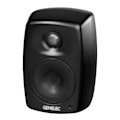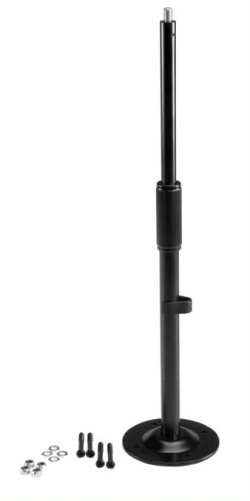When space is tight, the 4410A delivers the single cable networked convenience of Smart IP in a powerful, super-compact format.
4410A
Smart IP Installation Speaker

SPL
96 dB

Amplifier Power
18 W Bass (Class D) + 18 W Treble (Class D)

Frequency Response
67 Hz - 40 kHz (-6 dB)

Accuracy of Frequency Response
± 2.5 dB (74 Hz - 20 kHz)

Driver Dimensions
⌀ 76 mm Woofer + ⌀ 19 mm Tweeter (view in inches)

Dimensions
H 181 x W 121 x D 115 mm, (view in inches)

Weight
1.5 kg / 3.3 lb

Connections
1 x RJ45 AES67 / Dante Input
4410A Installation Speakers
Technical Specifications
When space is tight, the 4410A delivers the single cable networked convenience of Smart IP in a powerful, super-compact format.
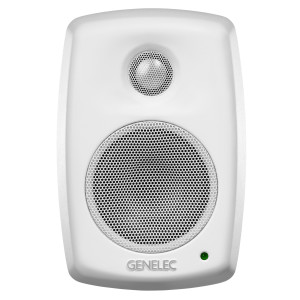
System Specifications
Frequency Response
74 Hz - 20 kHz (± 2.5 dB)
Low cutoff -6dB
67 Hz
High cutoff -6dB
40 kHz
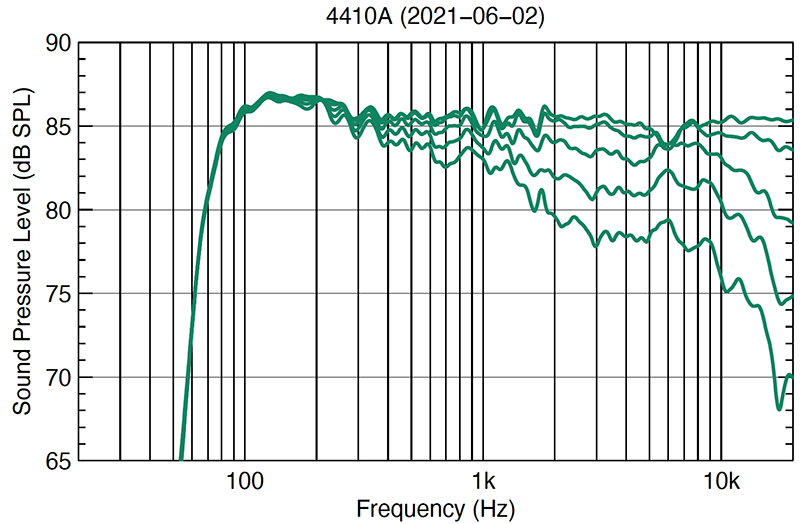
SPL
Peak SPL Maximum peak acoustic output per unit in a listening room with music material, at 1 m, using PoE+ power.
≥100 dB
Short term max SPL Maximum short-term sine wave output on axis in half space, average 100 Hz to 3 kHz, at 1 m, using PoE+ power.
≥96 dB
Long term max SPL Maximum long-term RMS acoustic output in same conditions with IEC-weighted noise, at 1 m using PoE+ power (limited by driver unit protection circuit and the PoE power supply being used).
≥91 dB
Self-generated noise
Self-generated noise Self generated noise level in free field at 1 m on axis (A-weighted).
≤5 dB
Weight
Weight1.5 kg (3.3 lb)
Dimensions
Height
181 mm
Width
121 mm
Depth
115 mm

Enclosure
Enclosure material
Die cast aluminium
Enclosure type
Reflex port
Drivers
Driver type
Cone
Diameter
76 mm
Driver type
Metal dome
Diameter
19 mm
Directivity


Harmonic distortion
> 200 Hz ≤0.5 %
Amplifier Section
Amplifiers
18 W Class D
18 W Class D
Mains voltage
PoE+/PoE
Power consumption
ISS Active
≤3 W
Idle
≤4 W
Full output
30 W
Signal processing section
Connectors
Input Ethernet (Power over Ethernet and Audio over IP)
Product Variants
Product codes
For even more technical details please see product operating manual.

Power to the speaker
Our most compact Smart IP loudspeaker, the 4410 uses PoE to produce uncompromised SPL and acoustic performance, and is fully compatible with both Dante and AES67 IP streams. Offering extraordinary coverage, clarity and intelligibility, the 4410 is manufactured in Finland using certified sustainable methods – providing decades of reliable service.

Power to the installer
The 4410 integrates tightly with our Smart IP Manager software – which allows installers to configure an almost unlimited number of rooms, zones, loudspeakers and audio channels, and includes device discovery, a versatile room EQ tool set, system organisation and status monitoring. Our new Smart IP Controller app can then be downloaded to either smartphone or tablet to give the end user day-to-day control of mute, volume, power on/off and zone control. Easy.
Key Technologies
Audio-over-IP (AoIP)
PoE Power
Smart IP Manager

Active Crossovers

Directivity Control Waveguide (DCW™) Technology

Intelligent Signal Sensing (ISS™) Technology

Minimum Diffraction Enclosure (MDE™) Technology

Optimised Amplifiers

Protection Circuitry

Reflex Port Design

Versatile Mountings
Audio-over-IP (AoIP)
The advancing adoption of networked audio has been huge, so we've responded by developing both AV loudspeaker and studio solutions that support AoIP streams, with all the precision and clarity that audio professionals have come to rely on from Genelec.
For demanding AV applications, our growing family of Smart IP loudspeaker models support Ravenna and Dante-compatible AES67 streams. Smart IP employs uncompressed low-latency audio streaming directly into each loudspeaker, with loudspeaker synchronisation to sub-microsecond level for solid acoustic imaging.
For audio professionals using AoIP connectivity, the Genelec 9401A System Management Device enables the smooth integration of Smart Active (SAM) Monitors and Subwoofers into SAM system layouts, from stereo to immersive, using ST2110, AES67 and Ravenna streams as the source – while offering full support for room adaption from our powerful Genelec Loudspeaker Manager (GLM) software.
PoE Power
Power-over-Ethernet allows our Smart IP loudspeakers to deliver impressive performance over a single CAT cable.
Our Smart IP loudspeakers support the widely used PoE+ and PoE technology standards. IEEE 802.3at (30 W) is recommended, with IEEE 802.3af (15 W) simply reducing the time that maximum power output can be maintained.
Smart IP loudspeakers utilise proprietary internal power management that delivers a significantly higher SPL than was previously possible via any conventional PoE. In fact, Smart IP can produce maximum SPL whenever needed, sufficient to power small and medium sized audio systems — a world first.
Smart IP’s internal power supply stores power, to enable Smart IP loudspeakers to work with real audio signals, music, and speech. Since audio signals are dynamic, periods of high peak power typically have finite duration while the effective average power level, or RMS power, remains much lower.
By employing PoE over a single standard CAT cable, Smart IP loudspeakers offer low power consumption and reduced cabling requirements, for a sustainable and affordable loudspeaker solution.
Smart IP Manager
Powerful software that provides total control of Smart IP networked loudspeaker systems.
To address the specific needs of installers, Smart IP Manager offers an array of software tools focused on solving specific installation audio problems – including device discovery, room equalisation, system organisation and status monitoring. This saves installers a substantial amount of working time and ensures that Smart IP loudspeaker systems always perform with outstanding clarity and speech intelligibility – even in acoustically challenging environments.
Smart IP Manager software is specifically designed to be used by installers during the system set-up, and allows the configuration of almost unlimited numbers of rooms, zones, loudspeakers and audio channels. After which, a public API command set allows Smart IP speakers to then be integrated into house automation systems ¬– enabling end user control of simple parameters including volume, power on/off, loudspeaker activity and a section of pre-programmed settings.
To help cope with challenging acoustic environments, Smart IP Manager integrates with the loudspeaker’s internal DSP to enable the analysis and corrective equalisation of any detrimental room acoustics, along with control of delay and level alignment. Internal memory within the speaker then provides instant recall of settings, allowing fast and accurate deployment in any environment.
Active crossover operating at low signal levels.

Audio electronic crossovers allow the audio signal to be split into separate frequency bands that are separately routed to individual power amplifiers, which are then connected to specific transducers optimised for a particular frequency band.
Active crossovers come in both digital and analogue varieties. Genelec digital active crossovers include additional signal processing, such as driver protection, delay, and equalisation.
Genelec analogue active crossover filters contain electronic components that are operated at low signal levels suitable for power amplifier inputs. This is in contrast to passive crossovers that operate at the high signal levels of the power amplifier's outputs, having to handle high currents and, in some cases, high voltages.
In a typical two-way system the active crossover needs two power amplifiers — one for the woofer and one for the tweeter.
The active crossover design offers multiple benefits:
- The frequency response becomes independent of any dynamic changes in the driver's electrical characteristics or the drive level.
- There is increased flexibility and precision for adjusting and fine-tuning each output frequency response for the specific drivers used.
- Each driver has its own signal processing and power amplifier. This isolates each driver from the drive signals handled by the other drivers, reducing inter-modulation distortion and overdriving problems.
- The ability to compensate for sensitivity variations between drivers.
- The possibility to compensate for frequency and phase response anomalies associated with a driver’s characteristics within the intended pass-band.
- The flat frequency response of a high-quality active loudspeaker is a result of the combined effect of the crossover filter response, power amplifier responses and driver responses in a loudspeaker enclosure.
Using the active approach enables frequency response adjustments and optimisation of the full loudspeaker system, placed in various room environments, without expensive external equalisers. The end result is a simpler, more reliable, efficient, consistent and precise active loudspeaker system.
Directivity Control Waveguide (DCW™) for flat on and off-axis response.

A revolutionary approach was taken by Genelec in 1983 with the development of its Directivity Control Waveguide (DCW™). We have developed and refined this technology over more than 30 years to greatly improve the performance of direct radiating multi-way monitors.
The DCW technology shapes the emitted wavefront in a controlled way, allowing predictable tailoring of the directivity (dispersion) pattern. To make the directivity uniform and smooth, the goal is to limit the radiation angle so that the stray radiation is reduced. It results in excellent flatness of the overall frequency response as well as uniform power response. This minimises early reflections and provides a wide and controlled listening area achieving accurate sound reproduction on and off-axis.
Minimised early reflections and controlled, constant directivity have another important advantage: the frequency balance of the room reverberation field is essentially the same as the direct field from the monitors. As a consequence, the monitoring system's performance is less dependent on room acoustic characteristics.
Sound image width and depth, critical components in any listening environment, are important not only for on-axis listening, but also off-axis. This accommodates not only the engineer doing their job, but also others in the listening field, as is so often the case in large control rooms.
DCW™ Technology key benefits:
- Flat on and off-axis response for wider usable listening area.
- Increased direct-to-reflected sound ratio for reduced control room coloration.
- Improved stereo and sound stage imaging.
- Increased drive unit sensitivity up to 6 dB.
- Increased system maximum sound pressure level capacity.
- Decreased drive unit distortion.
- Reduced cabinet edge diffraction.
- Reduced complete system distortion.
Intelligent Signal Sensing (ISS™) for power consumption reduction in stand-by mode.

Introduced early 2013, Genelec’s Intelligent Signal-Sensing technology has been developed to meet with both European Union ErP Directives and Genelec's own ambitious sustainability standards.
The Intelligent Signal Sensing, ISS™ circuitry tracks the signal input of the loudspeaker and detects if it is in use. If the ISS circuit does not find any audio on the input for a period of time, it sets the loudspeaker to a low-power sleep state and the loudspeaker will consume less than 0.5 watts. When an input signal is detected, the loudspeaker immediately turns itself on.
Additionally an ‘ISS Disable’ switch is located on each product’s back plate next to the other room response controls. First, when the mains power switch of the loudspeaker is set to 'ON', the ISS™ auto-start function (low-power sleep state on/off) of the loudspeaker is active.
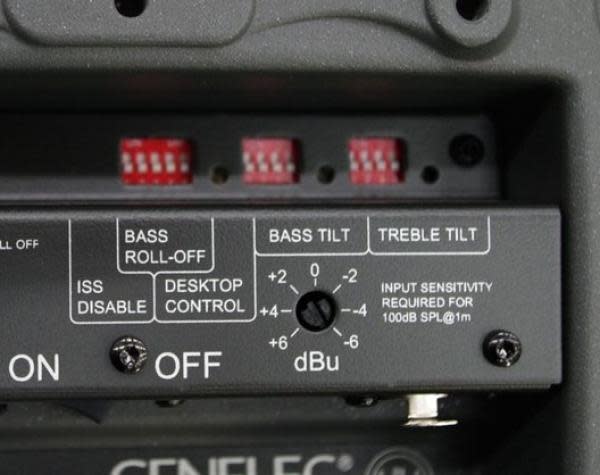
If this function is not desired, the ISS™ function can be disabled by setting the 'ISS Disable' switch on the back panel to 'ON' position. In this mode, the monitor is only powered on and off using the mains power switch.
Note that the mains power switch will always turn the monitor off completely.
Minimum Diffraction Enclosure (MDE™) for uncoloured sound reproduction.

A common problem with standard free-standing loudspeakers is that the front baffle discontinuities cause diffractions and the loudspeaker sharp corners act as secondary sources through reflections.
In order to improve the flatness of the frequency response and the power response of free standing loudspeaker systems, Genelec have designed a highly innovative enclosure optimized to match the properties of the monitor drivers, featuring rounded edges, and gently curved front and sides. In addition to achieving an unsurpassed flatness of the frequency response, the enclosure having minimum diffractions yields superb sound stage imaging qualities.
To achieve such a smooth and elegantly curved cabinet surface and to reduce the outer dimensions of the enclosure, maximising at the same time the internal volume for improved low frequency efficiency, we designed a cabinet made off die-cast aluminium. Aluminium is lightweight, stiff and very easy to damp to yield a “dead” structure. The cabinet walls can be made fairly thin, providing at the same time good EMC shielding and excellent heat sink for the power amplifiers. Die-casting is made in two parts, front and rear, and they are easy to separate for potential servicing needs.

The DCW waveguide has been integrated in the MDE aluminium enclosure to provide improved control of the loudspeaker’s directivity. Basically, the low frequency limit for constant directivity is determined by the size of the waveguide, so the larger the surface the better the control. With a very controlled off-axis radiation, the listening window becomes consistent, which is of utmost importance with multi-channel audio monitoring. Controlled directivity also reduces possible first order reflections on surfaces near the loudspeaker, helping to provide consistent audio reproduction in different acoustical environments. In fact, the entire front baffle is gently curved and the acoustically transparent grilles are part of the outer cabinet aesthetics, blending perfectly with the various other curved surfaces.


Each transducer is driven by its own optimised amplifier.

Audio electronic crossovers allow to split the audio signal into separate frequency bands that can be separately routed to individual power amplifiers, which are then connected to specific transducers optimised for a particular frequency band.
In a typical 2-way loudspeaker system, the active crossover needs two power amplifiers — one for the woofer and one for the tweeter. The power amplifiers are connected directly to the drivers of an active loudspeaker, resulting in the power amplifier’s load becoming much simpler and well known. Each driver-specific power amplifier has only a limited frequency range to amplify (the power amplifier is placed after the active crossover) and this adds to the ease of design.
The active design principle offers multiple benefits:
- The power amplifiers are directly connected to the speaker drivers, maximising the control exerted by the power amplifier’s damping on the driver’s voice coil, reducing the consequences of dynamic changes in the driver electrical characteristics. This may improve the transient response of the system.
- There is a reduction in the power amplifier output requirement. With no energy lost in the passive crossover filter components, the amplifier power output requirements are reduced considerably (by up to 1/2 in some cases) without any reduction in the acoustic power output of the loudspeaker system. This can reduce costs and increase audio quality and system reliability.
- No loss between amplifier and driver units results in maximum acoustic efficiency.
- Active technology can achieve superior sound output vs. size vs. low frequency cut-off performance.
- All loudspeakers are delivered as a factory aligned system (amplifiers, crossover electronics and enclosure-driver systems).
Sophisticated drive unit protection circuitry for safe operation.

When working in critical audio production environments it is essential that monitoring systems remain reliable and functional at all times. One of the main reasons behind Genelec’s excellent success in broadcasting environments is the reliability of our products and a key element behind the reliability is the internal protection circuitry found in all products since 1978.
The protection circuitry prevents driver failures by detecting signal levels, and in case of sudden peaks or constantly too high levels, taking the signal level down automatically. Of course this feature does not affect the sound quality in any way when working within the specifications of the loudspeaker, but only prevents inadequate input signals from breaking the loudspeaker.

Protection circuitry features and benefits:
- Reduces the output level when required, (e.g. when driver voice coil temperature reaches the safe limit), which highly improves system reliability.
- Appropriate protection circuitry design in every loudspeaker and subwoofer enables the maximisation of system output sound level.
Advanced reflex port design for extended low frequency response.

Genelec’s choice for vented, or reflex, enclosures dates back to the S30 model, the first Genelec product from 1978. Port performance has been improved and refined over the years with the aim to increase the woofer’s low frequency extension and sound pressure level capability to provide outstanding bass articulation and definition.
Both driver and vent contribute to the total radiation of a reflex enclosure. Most radiation comes from the driver, but at the vent-enclosure resonant frequency the driver displacement amplitude is small and most of the radiation comes out of the vent.
To minimise the air speed in the tube, the cross sectional area of the vent should be large. This in turn means that the vent tube has to be long which presents quite a design challenge.
The long, curved tube maximises airflow so deep bass can be reproduced without compression. The reflex tube terminates with a wide flare located on the rear of the enclosure, minimising port noises and providing excellent bass articulation.
The curvature of the tube has also been carefully designed to minimise any audible noise, compression or distortion. The inner end of the tube has proper resistive termination to minimise once again audible chuffing noise and air turbulence.
Proper reflex port design allows also to significantly reduce the woofer’s displacement, improving the linear low frequency output capacity.
Versatile mounting options for all installation needs.

In addition to perfect acoustical design and advanced tailoring options to optimize the loudspeaker’s behaviour to the room environment, Genelec loudspeakers offer a variety of mounting options for easy installation in different applications.
Our wide range of accessories and fixed mounting points on the back of our aluminium enclosure products offer solutions to all common installation situations. M6 support points have been integrated in the die-cast enclosure for wall and ceiling mounts.
Some models also feature a 3/8” thread at the bottom of the enclosure to fit a robust microphone stand. Other larger and heavier models feature M10 fixing points. Special floor stand plates have been designed in order to fit the Iso-Pod stand that is part of our product design.
With these features our loudspeakers have found their way to a variety of applications beyond the professional audio and studio world, for example in commercial and AV installation projects as well as in home environments all around the world.
References
Downloads
Documents
4410A Operating Manual Genelec Smart IP Brochure Smart IP FAQ Smart IP Manager - Operating ManualDownloads
4410A Line Drawing (PDF) 4410A Line Drawing (DWG) 4010A - Simulation File (EASE3) 4010A - Simulation File (EASE4) 4010A - Simulation File (GLL) 4410A Simulation File (CLF) 4410A BIM object (dwg) 4410A BIM object (dxf) 4410A BIM object (ifc) 4410A BIM object (pcp) 4410A BIM object (rfa) 4410A BIM object (skp)
Where to Buy?
1 x 4410A Smart IP Installation Speaker
1 x simple bracket
1 x mounting screw set
4410A
Awards
The super-compact 4410 loudspeaker | Genelec Smart IP
Genelec Smart IP | Premium networked audio for AV made simple
Genelec Smart IP | Quick Setup Guide - How to create a simple networked audio system
Genelec Smart IP Controller | Mobile and tablet app for Android and iOS
Smart IP Global Launch Event
Genelec Smart IP | Premium networked audio for AV made simple
Introducing Smart IP. Genelec's family of elegant loudspeakers for premium audio over a single CAT cable.
Genelec Smart IP | Quick Setup Guide - How to create a simple networked audio system
In this video, Genelec expert, Marcel Schechter, walks you through the basic steps of creating a Smart IP installation: Connecting the loudspeakers to the network switch with a CAT cable, connecting your computer to the network switch, downloading our free software and using Dante Controller/Virtual Soundcard.



















